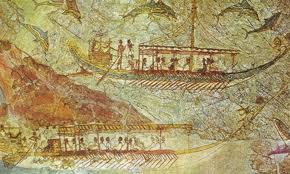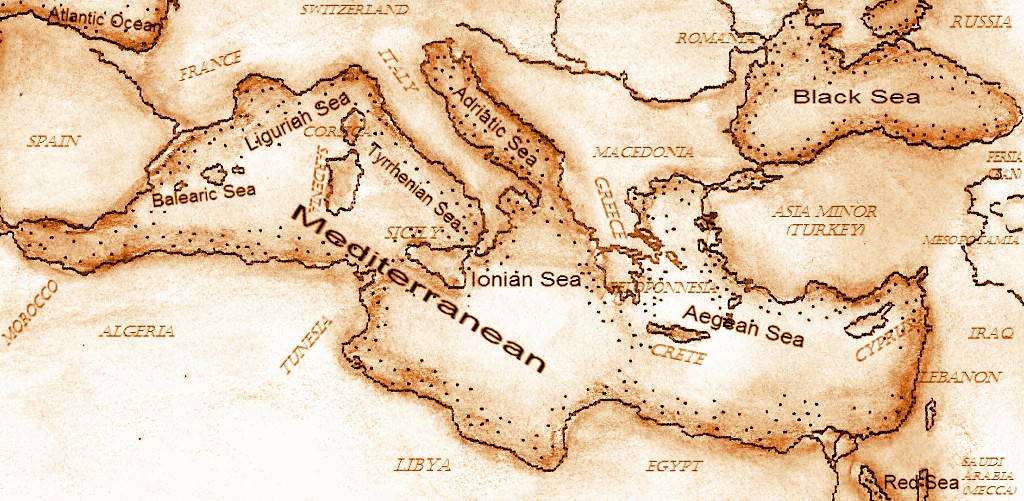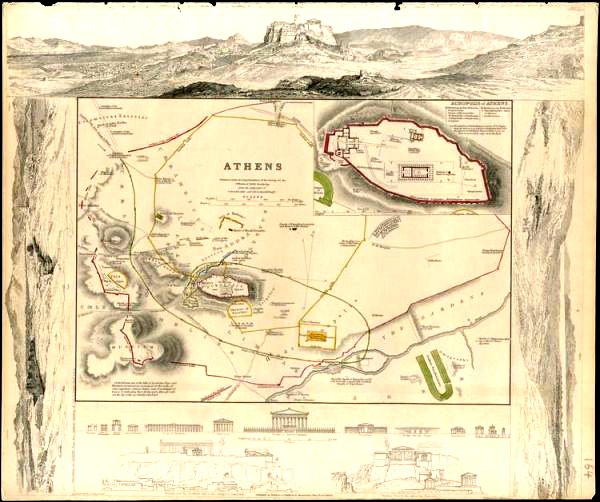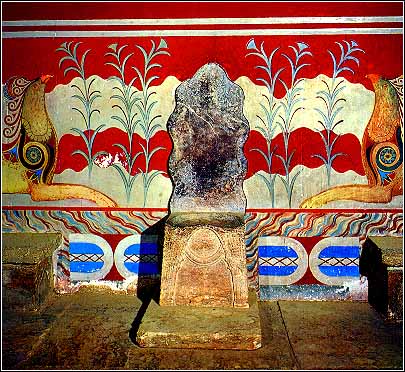
Mediterranean Civilizations
before 500 BC
The "Aegean Civilization" defines three cultures that merged between 3000 and 1200 BC around the Aegean Sea: Minoan, Cycladic and Mycenaean. Homer called them Achaeans.
The Mycenaeans, by far the largest group, were master craftsmen and architects. They entered the Greek peninsula from the north circa 2000 BC, bringing with them the base for the Greek language. They eventually invaded Crete and integrated the Minoan style into their own. Mycenaean culture reached its zenith around 1400 BC.
Circa 1200 BC internal squabbles, a possible earthquake and/or the Dorian invasions ended the Mycenaean culture. A long period of obscurity lasted until 900 BC.
In Greek mythology the Mycenaeans were descendants of Achaeus, king of Thessaly. His grandfather was Hellen, son of Pyrrha and Ducalion, whose father was the Titan Prometheus. When Zeus saw the evil ways of people he sent a great flood, sparing only Ducalion and his family. Forewarned by his father, Ducalion built a boat and after nine days landed on Mount Parnassus. From this came the word Hellenic, or Hellenism, to define ancient Greek civilization.
Hellen and Pyrrha gave birth to three sons, Xuthus, Aeolus and Dorus, providing Greece with four distinctive races: Achaeans, Aeolians, Dorians, and Ionians.
The Aeolians originally settled in Thessaly, a region in central Greece, and founded colonies along the coast of Asia Minor. The territory is called Aeolia, land of the Centaurs. It’s from Thessaly that the Argonauts (from the city of Argos) set sail in search of the Golden Fleece.
The Dorians, from their new base in Peloponnesus, pushed their way into parts of Asia Minor, Sicily, and southern Italy. By the 7th century bc Corinth had become the leading center for trade in Greece. Dorian migrations caused a mass exodus of Mycenaeans from the Peloponnesian peninsula, and many settled around a coastal strip of Asia Minor called "Ionia".
The Ionians, inspired by the art and architecture from the Orient and the Middle East, influenced artists, architects and craftsmen all along the Mediterranean coast. Ionian cities prospered until an invasion by Cyrus the Great, king of Persia, in 546 BC. The Ionians revolted against the next Persian king, Darius I, which resulted in the Persian Wars in 492 BC that lasted almost half a century. The Greek city-states finally united in face of the common enemy. Victory over the Persians gave the Greeks a new sense of cultural identity.
Civilizations from the Neolithic and Bronze Ages competing for maritime dominance around the Mediterranean.
The Mediterranean is actually an agglomerate of several seas. Its first societies appeared circa 10,000 BC along the Aegean and Ionian Seas with people of Indo-European origin (from east and north). Tribes from Asia Minor settled circa 7000 BC along the Aegean coast with metals, the wheel, advanced knowledge in farming, and horses.
The Minoan civilization (named after King Minos) became a highly sophisticated society on the island of Crete circa 3000 BC. The island was struck with either an earthquake, tsunami or volcanic eruption around 1700 BC and again around 1600 BC. Each time the Minoans rebuilt and continued to prosper with intense trade, in particular with Egypt. Their maritime supremacy over the Aegean ended when another natural catastrophy hit the island circa 1500 BC, coinciding with the rise of the Mycenaeans on the Greek mainland.
The Cycladic culture (Gr. circle) appeared on a cluster of small islands surrounding the “sacred” island of Delos. While Crete had no protective walls, Cycladic cities were surrounded by massive fortifications.


The Mycenaean world was made of several independent city-states surrounded by walls inspired by the Cycladic fortresses. The name derives from Mycenae, the capital in northern Peloponnesus. According to Homer, Agamemnon, king of Mycenae, was brother to Menelaus, king of Sparta and husband of Helen who, rightfully or wrongfully, is held responsible for starting the Trojan War.
The most powerful Greek city-states were :
Athens was the first society to set up a democracy (Demos; the people, Kratie; to rule) but it was repeatedly taken over by "despots". Some were benevolent, some not.


